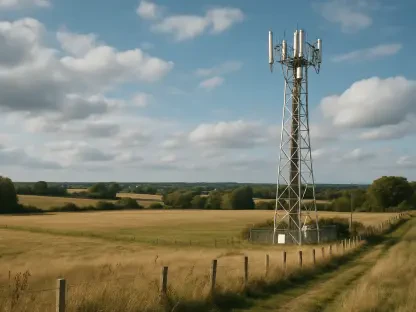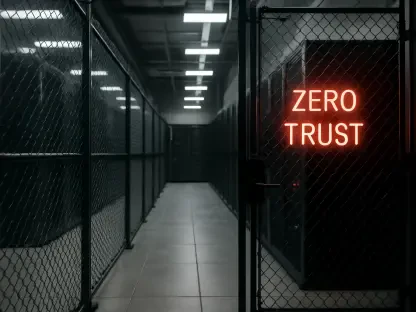In an era where cyberattacks are becoming increasingly sophisticated and frequent, the U.S. government faces an urgent need to safeguard its vast network of federal systems from breaches that could compromise national security and public trust. Imagine a scenario where a single hacker gains access to a critical agency database, only to find their progress halted not by chance, but by design—a system that inherently distrusts every user and device, no matter their credentials. This is the essence of zero-trust networking, a cybersecurity paradigm that has become a cornerstone of federal policy. With threats evolving at an unprecedented pace, driven by technologies like artificial intelligence, the push for zero-trust architectures reflects a strategic shift toward containment and resilience. This approach assumes no one is inherently trustworthy, demanding constant verification and segmentation to limit the damage of potential intrusions. The stakes couldn’t be higher, as the government grapples with shrinking response windows and the ever-looming risk of catastrophic breaches.
The Strategic Imperative of Zero-Trust Adoption
A Bipartisan Commitment to Cybersecurity
The drive to implement zero-trust architectures across federal agencies represents a rare point of bipartisan agreement in U.S. policy, underscoring the critical nature of cybersecurity in an increasingly digital world. This initiative, rooted in executive mandates from recent years, continues to hold strong as a priority, with officials emphasizing its role as a fundamental redesign of network security. Senior cybersecurity leaders have highlighted that the core expectations for zero-trust remain unchanged, with agencies developing detailed roadmaps to guide their transition. These plans are not mere formalities but are intended to address the persistent and evolving threats that target government systems. By focusing on strict authentication and access controls, the approach aims to prevent lateral movement by attackers within a network, effectively reducing the potential impact of a breach. This sustained commitment signals a recognition that zero-trust is not a temporary fix but a long-term strategy to counter sophisticated cyber risks that could undermine national interests.
Measuring Progress Through Data-Driven Metrics
Beyond policy endorsements, the adoption of zero-trust is being closely monitored through tangible metrics that assess the effectiveness of implementation across federal networks. Emphasis is placed on key indicators such as the speed of detecting intrusions, the time taken to respond, and the efficiency of mitigation efforts. These data points are crucial for understanding how well agencies are narrowing the “blast radius” of cyberattacks—a term used to describe the scope of damage a breach can cause. By isolating network segments and enforcing rigorous access protocols, zero-trust seeks to confine threats before they spread, a necessity in an era where response windows are shrinking. This focus on measurable outcomes reflects a broader shift in cybersecurity policy toward accountability and precision. Agencies are not just adopting new technologies but are redefining success by how quickly and effectively they can contain threats, ensuring that progress is not just theoretical but grounded in real-world impact.
Challenges and Future Directions in Implementation
Navigating the Complexity of Modernization
Implementing zero-trust architectures within the sprawling infrastructure of federal agencies is no small feat, given the diverse states of technological modernization across different systems. Cybersecurity officials have pointed out the difficulty in uniformly assessing an organization’s adherence to zero-trust principles when legacy systems coexist with cutting-edge solutions. Variations in identity and access management tools further complicate this process, requiring tailored approaches for each agency’s unique environment. The journey toward full adoption often involves evaluating telemetry data to understand network behavior, optimizing the use of existing tools, and forging strong partnerships with technology vendors to enhance solution effectiveness. This complexity underscores the reality that zero-trust is not a plug-and-play model but a dynamic framework that must adapt to the specific needs and constraints of each organization, demanding patience and persistent effort from all stakeholders involved.
Fostering Cultural Acceptance and Communication
Equally challenging is the human element of zero-trust adoption, as cultural acceptance within agencies plays a pivotal role in its success. Not every employee or department is naturally inclined to embrace cybersecurity changes, especially when they disrupt established workflows or introduce additional layers of verification. Communicating the value of zero-trust to all levels of an organization is essential to overcoming resistance and ensuring compliance. This involves educating staff on why these measures are necessary, framing them not as burdens but as critical protections against real threats. By addressing concerns and highlighting benefits, such as enhanced safety of sensitive data, agencies can build a shared understanding of the importance of this shift. This focus on engagement reveals a broader truth: technical solutions alone cannot secure networks without the support and cooperation of the people who use them, making cultural adaptation a cornerstone of sustainable cybersecurity policy.
Reflecting on Past Efforts for Future Resilience
Looking back, the journey to prioritize zero-trust networking within federal systems demonstrated a profound acknowledgment of the limitations of traditional cybersecurity defenses against modern threats. Discussions among top officials revealed a unified resolve to limit the impact of inevitable breaches by embedding a mindset of inherent distrust in network design. The challenges of modernizing diverse systems and securing buy-in from all stakeholders were met with innovative strategies and persistent dialogue. As efforts unfolded, the emphasis on measurable progress and containment provided a clear framework for success, even when timelines slipped. For the future, agencies must continue refining these architectures by investing in advanced tools, fostering inter-agency collaboration, and maintaining a focus on education to ensure readiness for emerging risks. By building on these foundations, the path forward involves not just reacting to cyber threats but proactively shaping a resilient digital landscape that can withstand the challenges ahead.









